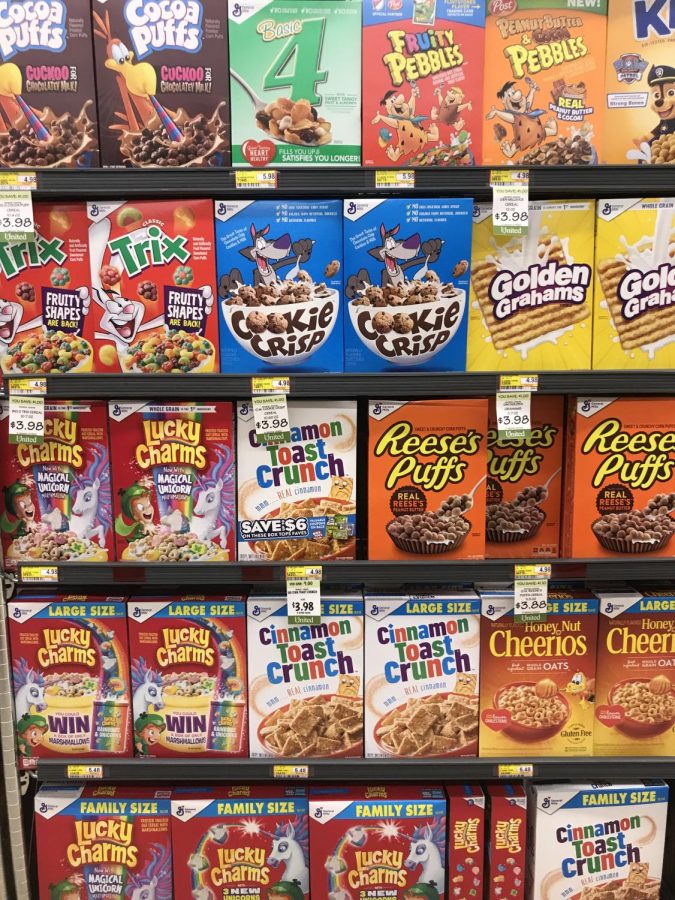Sugar-Coated Lies
November 26, 2019
“Don’t do drugs.”
The line almost every kid living in America has molded into their brains. Yet, children are consuming one of the most addictive drugs at a higher rate than ever before.
The Health Science Academy’s experiment confirmed that, “refined sugar is four times more addictive than cocaine!” We do not encourage kids to consume cocaine for breakfast, lunch or dinner, so why do we serve future generations this poison nearly every meal?
The American Heart Association recommends children between 2 to 18 years old to eat less than 6 teaspoons of added sugar per day. However, it seems more likely to find a diamond ring on the sidewalk than an American kid who eats the ideal amount of sugar.
Sugar is in yogurt, juice, and even ketchup. It is inescapable. Grocery store isles lure the eyes of millions of children by boasting of colors, toys and characters.
The billion-dollar cereal company, Kellogg’s, solicits “Froot Loops” with a friendly cartoon toucan and enticing rainbow colors. Consumers may justify their purchase of “Froot Loops” with its deceiving health claims of being a “good source of fiber” and “made with whole grain oats.” Yet, in reality they are consuming more than half of their recommended amount of sugar in just their first meal of the day.
With constant sugar consumption and poor nutrition, it is not surprising that nearly 30% of the American population is diagnosed with diabetes or prediabetes, as reported by the Centers for Disease Control and Prevention.
Not only can the addictive substance lead to disease and put lives in jeopardy, but it can also impair brain function. According to Huffington Post, a UCLA study found that a diet high in sugar “hinders learning and memory by literally slowing down the brain.” Those who over-consumed it had “damaged synaptic activity in the brain, meaning that communication among brain cells was impaired.”
Heavy sugar intake causes the body to develop a tolerance to insulin, often leading to diabetes. The study adds, “Insulin strengthens the synaptic connections between brain cells, helping them to communicate better and thereby form stronger memories.” Consequently, as excess sugar levels lower insulin levels in the brain, cognition is damaged.
Considering the facts, schools would be expected to be strong anti-sugar advocates. Yet, it is quite the contrary.
During the forty minute lunch period at SRHS, I surveyed more than forty kids buying their “lunch” from the enticing ice cream food truck parked next to the school. Their “lunches” varied from candy bars, bags of M&Ms, packets of red vines, and much more. Obviously, a very tasty lunch. But those five minutes of fleeting pleasure cannot be worth the detrimental consequences to their health.
School advisors stand aside in an attempt to protect the students from outside harms, when evidently, they should be stopping the ongoing “drug deals” happening virtually once a minute.
Even holidays that are supposed to be centered around relationships and family are also focused on sugar. On Halloween, millions of children can be spotted skipping down streets while carrying bags full of candy. Christmas calls for a time of presents and goodies. Valentine’s Day calls for a day of spreading love through heart-shaped chocolates.
This sugar epidemic is interfering with the health of countless people. Yet, many still seem unaware of its severity.
In May of 2012, the mayor of New York, Michael Bloomberg, proposed the Portion Cap Rule. The rule would ban any sugary beverages over 16 ounces from being sold.
Numerous fast food restaurants sell up to 42 ounce sodas, such as the McDonald’s Supersize Coke. These unnecessarily massive beverages contain more than 120 grams of sugar, which is nearly five times the amount of sugar children are recommended to have per day.
However, the ban faced opposition from several food chains and consumers. In Rachel Weiner’s article, The New York City Soda Ban Explained, State Supreme Court Justice Milton A. Tingling Jr. called the ban “arbitrary and capricious.”
Opponents were concerned the health department would have too much power and that consumers should be able to decide for themselves what to buy and eat. But consumers should not be permitted to make their own decisions if their decisions are ultimately harming them.
Undeniably, it is in our nation’s best interest to stop sugar-coating the lies.






































